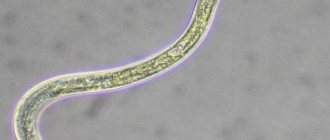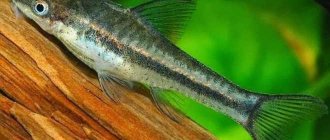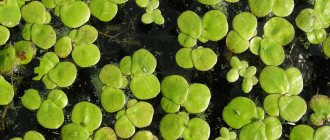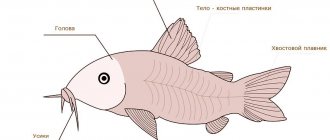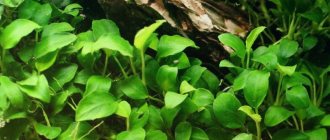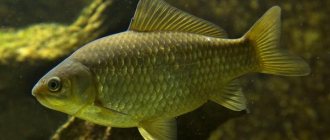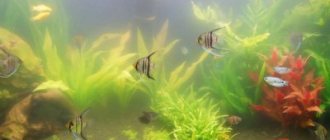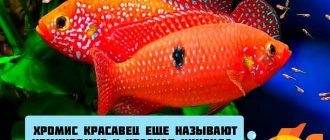Appearance
These fish belong to the Karpov family. They have whiskers, characteristic of most species of this taxon, near the mouth opening. Adults in nature grow up to 16 cm, but in an aquarium, even a very spacious one, they rarely exceed 10 cm.
The body is elongated, rather narrow, silvery in the ventral region, slightly darker on the back. A dark stripe runs along the sides, continuing on the caudal fin. The fins themselves are almost transparent.
The Siamese algae eater has a very interesting resting posture. When the fish wants to rest, it lies down on the ground or on large leaves of plants, resting on them only with its tail and ventral fins.
Siamese algae beetle
Siamese algae
Kingdom : Animals - Animalia. Phylum: Chordata - Chordata. Class : Bony fish - Actinopterygii. Order: Cypriniformes. Family: Cyprinidae - Cyprinidae. Genus: Crossocheilus. Species: C. oblongus. Binomial name: Crossocheilus oblongus (Huhl & van Hasselt, 1823).
Comfortable water temperature: They prefer water temperatures in the range of 24 - 26 C.
"Acidity" Ph: 6.5 — 8.0.
Hardness dH: 5 — 20.
Behavior: Aggression can be shown towards relatives, but they are non-aggressive towards other fish.
Content difficulty: easy.
Feeding and diet of Siamese algae eaters: red algae - “blackbeard”, “flip-flop”, filamentous algae. Special foods containing plant ingredients.
Sexual differences: Algae eaters are difficult to distinguish, sexual dimorphism is weakly expressed. Adult females have a fuller (rounded) shape.
Size in nature: from 10 to 14 cm.
In an aquarium: 7 - 8 cm.
They can live about 10 years.
The Siamese algae eater is a representative of a species of freshwater fish of the carp family. This is a bottom-dwelling tropical fish that has settled in southeastern Asia, which includes the Chao Phraya and Mekong basins, as well as the Malay Peninsula. Their natural habitat is streams and rivers, as well as flooded forests during the rainy season. Siamese algae eaters should not be confused with fox (Epalzeorhynchos kalopterus) or the False siamensis (Garra cambodgiensis). In true Siamese, the black stripe runs along the entire body, including the caudal fin, while in false Siamese it ends at the tail.
We recommend a video about algae eaters
Features of the Siamese algae eater
Siamese algae eaters have a black horizontal stripe extending from the gills to the tail, inclusive. The true one, Crossocheilus siamensis, does not have maxillary antennae, but has a specific upper lip shape and is rarely found commercially.
Usually, in pet stores, under the guise of Siamese algae eaters, they sell fish that eat red algae - Crossocheilus langei . They have a bright brown elongated body with a slightly flat belly. In addition, they have a noticeable black and brown horizontal stripe extending from nose to tail. These fish can grow up to 16 cm in length. These fish also have small maxillary antennae and an arched upper lip.
Another species of algae eater that is traded under the guise of a “Siamese” is Crossocheilus atrilimes .
One way or another, all “Siamese algae eaters” are hardy fish, they are popular and effective in the fight against algae in the aquarium. These are very active and fast-swimming fish that move in schools, but some individuals can express aggression towards their own kind and related fish. Algae eaters can easily be kept in a community aquarium; they are less aggressive than their counterparts - Chinese algae eater.
The only thing with them is that they are large. Many experienced aquarists take a crowd of young animals, and then, when they grow up, they give away the old ones and take a new batch of young cods. It is noted that young units are much more effective than old ones.
If you are still thinking about purchasing these fish, we note that 2-3 cod will not help you much. We need a fighting group against the same black beard. The situation with them is approximately the same as with otocinclus - useful, but to get a good effect you need an army. And here the question arises: isn’t it easier to focus on the balance of the aquarium? And somehow comprehensively maintain the biobalance in the aquarium? Rather than spending your hard-earned money set aside for a fur coat for your wife... and buying an army of gray sausages =)
Siamese algae eater photo
As for the conditions of keeping Siamese algae eaters. Everything here is standard, as for all tropical fish. Requires filtration, aeration of water, weekly replacement of 1/4 of the water with fresh water. The most important thing is that there are no excessive concentrations of nitrogen compounds and phosphates . Every conscientious aquarist should always have a set of drop tests on hand, at least for nitrate and phosphate. Fortunately, they have now become inexpensive, there are no problems with their assortment and acquisition. For example, we can with a clear conscience recommend you the cool UHE drop tests, , but they are sold only online. In stores in your city - offline, you can find inexpensive Vladox tests .
Siamese algae eater photo
When changing water, it would be a good idea to use clean water supply and use drugs that block harmful substances. For example, Tetra AquaSafe - it blocks chlorine compounds, heavy metals + contains B vitamins, iodine and other aquarium goodies.
Siamese algae eaters do not need personal feeding. They will always find something to chew in your aquarium. But like all fish, they will readily eat any Tetra food.
Keep in mind that if you start giving them too many treats, they will become lazy about eating the seaweed. Why work if you give delicacies every evening.
Video about Siamese algae eaters +
Subscribe to our YouTube channel so you don't miss anything
See also: Other fish that eat algae
Otocinclus
Garra Rufa Ancistrus Poecilia Molliesia
Other articles on the topic Algae in the aquarium Aquarium cleaners - algae eaters
Diseases and treatment of aquarium plants How to deal with Blackbeard algae
Category: Aquarium articles / Aquarium fish | 493 | Date: 23-03-2013, 10:22 | Comments (15)
We also recommend reading:
- — Water eyes
- — All about aquarium aeration
- — Gambusia
- — Geophagus brasiliensis
- — Geophagus Steindachner
Spreading
Crossocheilus siamensis is native to Southeast Asia.
Here in Indochina, they live in small rivers and streams of the Mekong River basin. In its natural environment, the algae eater can be found in Indonesia, Suriname, Thailand, and the Malay Archipelago.
Reservoirs usually have a current, their bottom is sandy, and at the bottom there are many snags and boulders, which are used as shelters.
The sun's rays penetrate well through fairly clear water, which causes active growth of algae, which ensures the food preferences of fish.
Keeping in an aquarium
Keeping Siamese is relatively easy, since aquarium fish are unpretentious. The volume of the aquarium should be at least 100 liters of water, since algae eaters are energetic and active. For the same reason, the tank is equipped with a lid or mesh on top to prevent pets from leaving the artificial pond.
Water indicators:
- acidity – 4–6 pH;
- hardness – 5–15 dH;
- water temperature – 24–26C.
An aquarium with Siamese is decorated with grottoes, shelters and caves, because due to an underdeveloped bladder, the fish often rest, hiding at the bottom or in algae. Vegetation is planted to suit your taste, but it is important to leave a free area for swimming.
The soil for an artificial pond with cods is rocky soil or pebbles. Also, filtration and aeration must be installed in the aquarium, since pets require a fast current to be kept comfortably in the tank.
Maintenance and care
These useful, but not too colorful fish from Southeast Asia are not difficult to breed: they are unpretentious in food and not too demanding in terms of keeping conditions. However, it is worth adhering to the maintenance recommendations, since unsuitable conditions lead to poor fish species and their early decline.
Aquarium
The Siamese algae eater is used to moving quite a lot and actively, so the aquarium for it should be quite large, preferably elongated in the horizontal direction, so that a kind of “corridor” for movement can be created.
Considering that algae eaters are rarely the only inhabitants of the tank, it is better to place them in an aquarium of at least one hundred liters.
Several fish should not feel crowded - otherwise they will try to jump out.
However, even in good conditions, the algae eater is not averse to “checking” what is happening in the air - so you should definitely cover the aquarium with a cover glass or mesh.
Water parameters
Crossocheilus siamensis prefer neutral or slightly acidic water. The optimal balance ratio is 6 - 7 pH, acceptable - from 5.5 to 8. Algae eaters are not too demanding of hardness.
Unlike aquarium fish from Central Amazonia, these inhabitants of Indochina normally tolerate water hardness up to 20 dGH. However, it is better to maintain a stable indicator at a lower level, around 15 dGH.
The normal tolerance of cyprinids to fairly hard water means that when starting an aquarium that will contain more fastidious fish along with the Siamese algae eater, you should focus on creating the hardness parameters on the latter.
The temperature range of Crossocheilus is suitable for many fish and plants and ranges from 23 to 26°C. It is better not to allow the water to cool too much, so moderate heating may be required in winter.
It is necessary to filter and saturate the water with oxygen. For large aquariums, it is better to purchase a remote filter.
Expert opinion
Andreev Roman Stanislavovich
Hydrobiologist with 18 years of experience.
Ask a Question
The creation of an artificial current will help keep the Siamese algae eater active. Any constant movement of water will be a good imitation of natural habitat conditions.
Lighting
Fish are not too picky about lighting conditions. They tolerate both bright and diffused light well. The duration of daylight hours should be approximately 10 - 12 hours. Artificial lighting can be combined with natural lighting, the main thing is that it is indirect.
Feeding
- In the diet of the Siamese algae eater, it is important to combine animal and plant foods. Contrary to the name, algae is not the only food for these fish. They readily eat bloodworms, tubifex, daphnia, and coretra in live and frozen form.
- Pre-steamed green vegetables - cucumbers, zucchini, spinach - are absorbed from plant components. If there is enough food, the fish will not pay attention to algae, even if it is in the aquarium. To provoke Crossocheilus siamensis to eat them, food doses are kept within certain limits, slightly underfeeding.
Under these conditions, the Siamese algae eater gradually destroys Vietnamese, blackbeard and other filamentous algae. However, the beneficial fish can cause irreparable damage to aquarium moss plantations, especially Javanese moss - it gnaws it clean.
Diseases and treatments
Algae eaters are prone to obesity and stress. In the first case, you need to adhere to feeding standards, in the second, determine the cause of the malaise. When the fish is stressed, the color of the side stripe changes and it becomes light. This can be caused by several factors: temperature fluctuations in the aquarium, violation of hardness and acidity standards, undesirable proximity to other fish. If the water is not changed on time, its quality can also cause stress in the algae eater. This phenomenon occurs as a result of keeping two or more males in one container, who are fighting for territory. To relieve your fish of stress, you need to eliminate the cause.
Reproduction
The natural reproduction of the Siamese algae eater is accompanied by seasonal migrations up rivers, where the water is softer and the conditions are slightly different. To this day, the mechanisms that trigger the spawning process have not been fully studied. The only obvious fact is that it is almost impossible to provoke the reproduction of this fish in aquarium conditions, even by creating specific conditions in the spawning area.
All fish that can be found on sale are either caught in the natural environment or raised in special fish farms, most of which are located in Thailand. To start the reproduction process, they use special hormonal preparations, the composition of which they try not to disclose.
Sexual dimorphism is weakly expressed. Typically, females are slightly larger and have a more convex abdomen.
Features and species diversity of algae eaters
Algae eaters are a large group of fish with a huge number of representatives, each of which has its own characteristic features. The presence of this type of fish in the aquarium will allow:
- reduce the frequency of cleaning the aquarium;
- prevent algal bloom;
- clean up any remaining algae that is invisible to humans.
The fish will serve as natural orderlies for the aquarium.
| Name | Appearance | Peculiarities |
| Chinese algae eater | Sucker-shaped mouth, yellow scales | The structure of their mouth makes them almost universal in the fight against various types of algae. However, Gyrinoheilus cannot eat filamentous algae, black beard and other filamentous algae. The suction cup allows you to remove green deposits on flat surfaces. |
| Ancistrus | They can reach 15 cm; males have growths on their heads. Preferably brown. | They need additional feeding with plant foods. For example, cucumbers or zucchini. Aggressive towards each other. |
| Otocinclus | Gained popularity due to its miniature size. Adults do not exceed 5 cm. Neon abdomen. | It is very picky about the composition of water and sensitive to macro- and microelements. Not suitable for beginners. Must be kept in a flock. |
| Epalceorhynchus piebald | Size up to 15 centimeters. | Shows no interest in tankmates. Universal in the fight against algae, including black beard. |
However, it is the Siamese algae eater that fights red algae, this is due to the fact that its homeland is Thailand.
Neighborhood
Siamese algae eaters do not have aggressive intentions towards any other species, however, within the flock “showdowns” between males are not excluded. The fish are very lively and active, they actively move around the aquarium, which can frighten or cause stress to too timid neighbors.
That is why among the neighbors of Siamese algae eaters there should not be some tetras, as well as cichlids, which protect their territory before breeding.
It is not recommended to keep individuals with veiled tails together with Crossocheilus siamensis - out of curiosity and due to natural activity, these nimble cyprinids tend to ruffle and bite such decorations.
Another unwanted neighbor is the Labeo. They belong to the same family as algae eaters, as a result of which interspecific fights between males are possible.
Feeding
The main food of Siamese algae eaters is any type of algae. As a rule, having settled in a new place, they instantly destroy these harmful inhabitants of the aquarium.
A pest such as the black beard is considered a delicacy for them, which is why they are sometimes called bearded beetles.
As they grow older, they have to feed sai with regular fish food - live, vegetable, dry.
But, as a rule, adult individuals quickly get used to feeding and no longer destroy harmful algae so aggressively, so for thorough cleaning of the tank they purchase small young coyotes.
Adults usually don’t have enough algae alone. Therefore, they are provided with additional food in the form of:
- bloodworm;
- Artemia nauplius;
- tubifex;
- finely chopped vegetables and fruits - carrots, cucumbers, apples, cabbage, zucchini.


